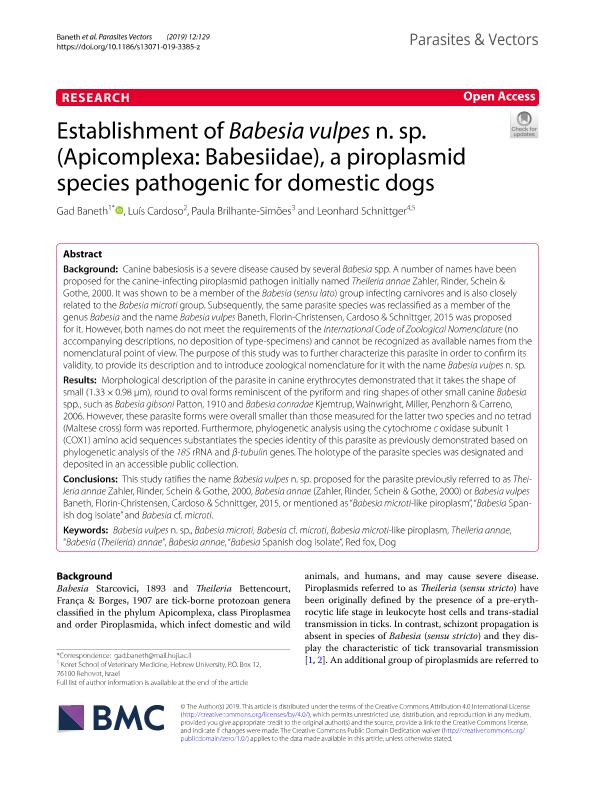Mostrar el registro sencillo del ítem
dc.contributor.author
Baneth, Gad
dc.contributor.author
Cardoso, Luís
dc.contributor.author
Brilhante Simões, Paula
dc.contributor.author
Schnittger, Leonhard

dc.date.available
2020-12-22T05:02:15Z
dc.date.issued
2019-03-26
dc.identifier.citation
Baneth, Gad; Cardoso, Luís; Brilhante Simões, Paula; Schnittger, Leonhard; Establishment of Babesia vulpes n. sp. (Apicomplexa: Babesiidae), a piroplasmid species pathogenic for domestic dogs; BioMed Central; Parasites and Vectors; 12; 129; 26-3-2019; 1-8
dc.identifier.issn
1756-3305
dc.identifier.uri
http://hdl.handle.net/11336/120999
dc.description.abstract
Background: Canine babesiosis is a severe disease caused by several Babesia spp. A number of names have been proposed for the canine-infecting piroplasmid pathogen initially named Theileria annae Zahler, Rinder, Schein & Gothe, 2000. It was shown to be a member of the Babesia (sensu lato) group infecting carnivores and is also closely related to the Babesia microti group. Subsequently, the same parasite species was reclassifed as a member of the genus Babesia and the name Babesia vulpes Baneth, Florin-Christensen, Cardoso & Schnittger, 2015 was proposed for it. However, both names do not meet the requirements of the International Code of Zoological Nomenclature (no accompanying descriptions, no deposition of type-specimens) and cannot be recognized as available names from the nomenclatural point of view. The purpose of this study was to further characterize this parasite in order to confrm its validity, to provide its description and to introduce zoological nomenclature for it with the name Babesia vulpes n. sp. Results: Morphological description of the parasite in canine erythrocytes demonstrated that it takes the shape of small (1.33×0.98 µm), round to oval forms reminiscent of the pyriform and ring shapes of other small canine Babesia spp., such as Babesia gibsoni Patton, 1910 and Babesia conradae Kjemtrup, Wainwright, Miller, Penzhorn & Carreno, 2006. However, these parasite forms were overall smaller than those measured for the latter two species and no tetrad (Maltese cross) form was reported. Furthermore, phylogenetic analysis using the cytochrome c oxidase subunit 1 (COX1) amino acid sequences substantiates the species identity of this parasite as previously demonstrated based on phylogenetic analysis of the 18S rRNA and β-tubulin genes. The holotype of the parasite species was designated and deposited in an accessible public collection. Conclusions: This study ratifes the name Babesia vulpes n. sp. proposed for the parasite previously referred to as Theileria annae Zahler, Rinder, Schein & Gothe, 2000, Babesia annae (Zahler, Rinder, Schein & Gothe, 2000) or Babesia vulpes Baneth, Florin-Christensen, Cardoso & Schnittger, 2015, or mentioned as “Babesia microti-like piroplasm”, “Babesia Span‑ ish dog isolate” and Babesia cf. microti.
dc.format
application/pdf
dc.language.iso
eng
dc.publisher
BioMed Central

dc.rights
info:eu-repo/semantics/openAccess
dc.rights.uri
https://creativecommons.org/licenses/by-nc-sa/2.5/ar/
dc.subject
"BABESIA (THEILERIA) ANNAE"
dc.subject
"BABESIA SPANISH DOG ISOLATE"
dc.subject
BABESIA ANNAE
dc.subject
BABESIA CF. MICROTI
dc.subject
BABESIA MICROTI
dc.subject
BABESIA MICROTI-LIKE PIROPLASM
dc.subject
BABESIA VULPES N. SP.
dc.subject
DOG
dc.subject
RED FOX
dc.subject
THEILERIA ANNAE
dc.subject.classification
Otras Ciencias Veterinarias

dc.subject.classification
Ciencias Veterinarias

dc.subject.classification
CIENCIAS AGRÍCOLAS

dc.title
Establishment of Babesia vulpes n. sp. (Apicomplexa: Babesiidae), a piroplasmid species pathogenic for domestic dogs
dc.type
info:eu-repo/semantics/article
dc.type
info:ar-repo/semantics/artículo
dc.type
info:eu-repo/semantics/publishedVersion
dc.date.updated
2020-11-11T12:39:08Z
dc.journal.volume
12
dc.journal.number
129
dc.journal.pagination
1-8
dc.journal.pais
Reino Unido

dc.journal.ciudad
Londres
dc.description.fil
Fil: Baneth, Gad. The Hebrew University of Jerusalem; Israel
dc.description.fil
Fil: Cardoso, Luís. University Of Trás os montes And Alto Douro; Portugal
dc.description.fil
Fil: Brilhante Simões, Paula. Serviços Especializados Em Veterinária; Portugal
dc.description.fil
Fil: Schnittger, Leonhard. Instituto Nacional de Tecnología Agropecuaria. Centro Regional Buenos Aires; Argentina. Instituto Nacional de Tecnología Agropecuaria. Centro de Investigación en Ciencias Veterinarias y Agronómicas. Instituto de Patobiología; Argentina
dc.journal.title
Parasites and Vectors

dc.relation.alternativeid
info:eu-repo/semantics/altIdentifier/doi/http://dx.doi.org/10.1186/s13071-019-3385-z
dc.relation.alternativeid
info:eu-repo/semantics/altIdentifier/url/https://parasitesandvectors.biomedcentral.com/articles/10.1186/s13071-019-3385-z
Archivos asociados
